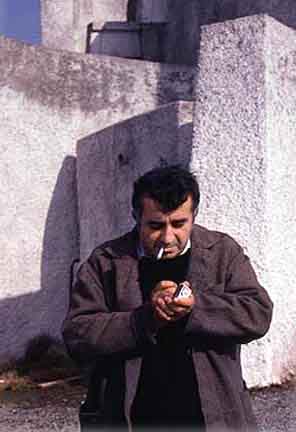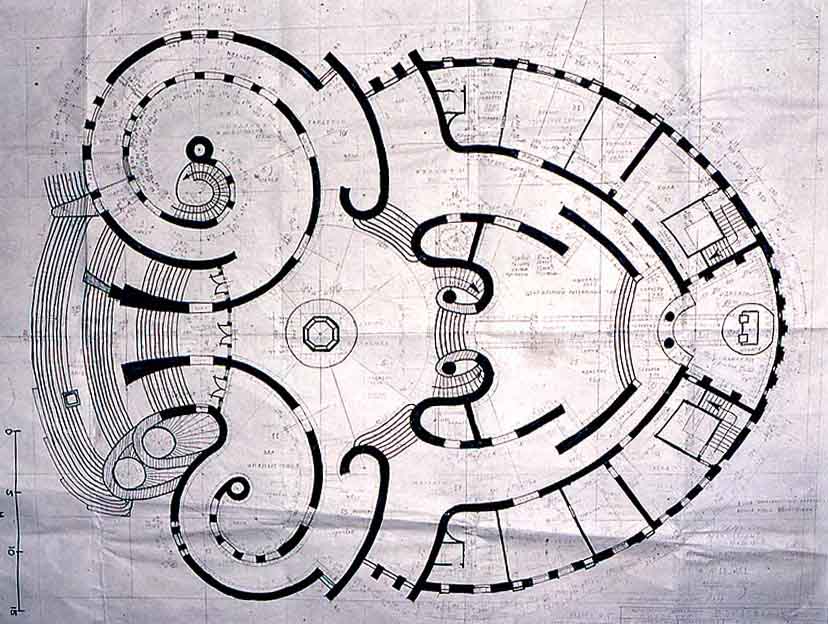
Click on the pictures, some can be enlarged!
|
In Memory of the Georgian Architect and Friend Victor Djorbenadze 1919 - 1999 |
1980 Victor in Mukhagdverdi
|
|
In 1980, roaming the city, I met Victor by chance - or better, he approached me near his house and office on the left bank - first in French then in German. Delighted to have found a foreigner who was interested in contemporary architecture, he drove me to a VIP-cemetery at Mukhagdverdi overlooking Mtskheta where he had built a chapel á la Le Corbusier. A sensational building considering that this was Brezhnev's Soviet Union.
Djorbenadze's cemetery chapel at Mukhagdverdi.
1984-1989 The Wedding Cathedral
When I arrived in Tbilisi four years later I noticed a stark new building on a promontory above the Kura. A cathedral for all I knew! The taxi driver could not explain its purpose - I did not understand enough Russian - and he had never heard of Victor Djorbenadze. Merab had never been there either, but pushed by me, he eventually made contact with Djorbenadze, and Victor gave us a leisurely tour taking us into every nook and cranny from the roof to the unfinished sub-basement.
During our conversation - in German which Merab did not understand - Victor made, among other comments on the political significance of his building, an audacious prediction: he prophesied the disappearance of the Soviet System and the Soviet Union as a political entity within five years! - It was May 1984, the Orwellian year of Andropov! Nobody was willing to believe me, but history happened exactly as he had foreseen. - He made no secret that he was close to Shevardnadze, the Chairman of the Georgian Communist Party - who had paid US$ 7 Million for the building. - which led to further interesting speculations on the intellectual climate in the last years of the USSR. Understandably, Victor asked me not to publish our conversation as the time. In 2001, after Victor had died and the Soviet Union was no more, I decided to tell the story of this meeting with Victor Djorbenadze as part of an internet appeal to save his crumbling cathedral. A copy of the
story of this visit is attached. Here I'll add some unpublished photos I took at the construction site in May 1984.|
The bell-tower of the Wedding Cathedral after the bell-cage had been installed. |
|
This picture gives an idea of complex architecture brut of the building. A view of the female, baptismal chapel and the split slabs of the bell-tower from the western entrance stairs. |
Five massive shells wrap the elliptical narthex ( view from the south) The altar-apse (east) is on the right, the bell-cage still on the ground. Notice - click on the picture for an enlargement - a dwarfed Merab is gazing up from directly underneath the crane tower!
|
A better southern view into the shell-leaves wrapping the nave. |
|
The building seen from across the Kura (west) |
|
|
If the outside of this building is impressive its interior is a highly sophisticated assemblage of architectural elements, many specifically Georgian. The internal resolution of the shell structure produces a space, which rivals that of Southern German Baroque churches, e.g. Balthasar Neumann's Vierzehnheiligen. The relationship of the various parts becomes clearer if one consults the construction plan further down. Two mirror-image spiral columns, one is seen here, carry the weight of the heightened roof structure above the altar apse. The bridge between them is intended for a choir - as in other Eastern-Orthodox churches there is no organ or instrumental music, only the vox humanum may sing the praise of God. Victor demonstrated the excellent, clear acoustics by singing a part of the Orthodox liturgy from up there. Eventually he had frescoes painted onto the flat wall surface between the column and the small door. The remaining walls are faced with limestone tiles.
Victor cited Le Corbusier's church at Rongchamp as an influence. This may be true for Djorbenadze's version of architecture brút, but this building is more emotional and humane than Le Corbusier's cool design and certainly more imaginative.
The ceiling above the altar is deep blue and supported by heavy, curved and gilded steel-girders. A fantastic effect.
Perhaps this photo reflects the subjective impression of the complex interior most closely. To the left the ceiling over the proscenium and the "Fountain of Life" is seen. It resembles the wooden false-dome structures of the oldest Georgian buildings - and similar stacked roofs in Buddhist Central Asia.
|
The Georgian ceiling of the proscenium. |
The center of the proscenium is the "Fountain of Life," connected in Orthodoxy with the Mother of God. In 1980 it was unfinished and could not be photographed effectively. After the 1986 inauguration of the building Victor sent me a set of pictures to show the sparse interior decorations.
|
View from the altar through the spiral columns towards the "Fountain of Life" and the stained-glass exit door. (photo by Djorbenadze, 1986) |
|
|
The "Fountain of Life," an octagonal "well" which reaches through three sub-levels to the very rock on which the building stands. Following a design by Victor the well is crowned by a metal sculpture by the brothers Irakli and Gogo Otchiauri: two peacocks supporting a globe on which sit two doves - symbols of physical and spiritual love. (photo by Djorbenadze, 1986) The "well" is a reminder of the octagonal structure at the center of Sv. Nino's church at Djvari Metskheti. This structure had great symbolic importance for Djorbenadze, it crystallized the humanist aspect of life..
Victor and Merab in the construction bureau in the cathedral. Victor had pulled out a floor plan of the building to explain his ideas, he stood back and smiled. "Take a look! What do you see?" On first glance I saw a face, perhaps a Chinese-monkey mask, but then in a flash I knew what it was: the anatomical cross-section of a female abdomen.... The uterus, the ovaries, the radiating ovum, and the vagina exiting between the two slabs of the bell-tower. This insight came so sudden and was so strong that my thought had escaped before I realized what I was saying. Victor stared at me and then shook his head. "Yes, that's what it is," he said raising his bushy brows, "You are the only person who has seen that.... My mother is a gynecologist. I took the design from one of her books. - But how could you know?" He spontaneously gave me the plan, which for several years hung in my office.
|
 |
Seen from the west, the left spiral block, resembling a snail, is, according to Victor, "male," here the groom's party assembles. The arcades on the outside of this block are reminiscent of the balconies of the palaces of the Georgian kings.... The bride enters through the right, "female" spiral block with its six asymmetrical window holes. The pair meets in front of the altar. After the ceremony they pass the fountain of life and exit through the central door between the slabs of the bell-tower. Baptisms were to take place in the innermost turn of the female spiral. - Merab got married in this cathedral in 1998!
1989 with Cornelius
In 1989 I took Nino, Merab, the Shcherbakovs, and Irakli there. The frescoes were finished, and the lighting fixtures and the stained glass windows had been installed. These sparse embellishments left the architecture as bare as Victor had envisioned. The building continued to be overlooked by most of the Tbilisi intelligentsia and the Patriarchy. A Swedish ignoramus objected vehemently to its existence - to them this was deplorable "Soviet" architecture....
|
Cornelius resting on the floor before the altar fresco painted by Zurab Nisharadze. |
|
Compared to Georgian paintings of the time, the altar fresco must be considered a tasteful success. Not surprising, it incorporates echoes of Lado Gudiashvili: the hands of the Mother of Georgia, Deda Sakartveli, Shota Rustaveli the Bard as bag-pipe player, and the Man in the Tiger Skin presenting the church are all figures from Gudiashvili's repertory. Victor was a great admirer of Gudiashvili. |
|
The mythological fresco on the wall to the left of the stairs to the altar... |
|
...and the Rape of Europa on their right. |
|
The Georgian Hermaphrodite |
On the western exit-stairs Djorbenadze had erected a column on which he wanted to place a copy of Praxitiles' Hermes (in the Museum in Olympia) carrying his son by Aphrodite on his arm: Hermaphrodites! Apparently this project did not succeed, and he replaced the sculpture with a cast bronze copy of Hellenistic Hermaphrodite from the second-century AD found in an archeological dig in the Georgian Kolchis....
On my next visit to Tbilisi in 2001 this monument to Georgian spiritual strength and spectacular piece of world architecture had sunk into disuse and was crumbling. The Patriarch, financed by President Shevardnadze, was building an immense "Church of all Faiths" to immortalize themselves. The Wedding Palace was for sale. Thank God, the government did not have the funds to put it under the hammer. It was, as Djorbenadze had said, "cast in concrete." The building would weather not only Communism but also the times thereafter!
The story has a typical, novo-Georgian happy-end. In 2001 the Wedding Palace was bought by the Georgian, formerly Muscovite, Oligarch Badri Patarkatsishvili for a cool US$ 10 Million - paid to a nephew of Eduard Shevardnadze..... Because Badri is wanted by the Russian Mafia as well as by Interpol the building is protected by state police and off-limits to the curious. A friend of mine who has had access to Patarkatsishvili and has visited the Wedding Cathedral reports that its interior has been renovated. Badri uses it as his personal townhouse...!
.....Did I hear Victor laugh from his grave?